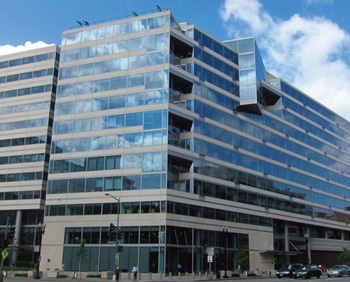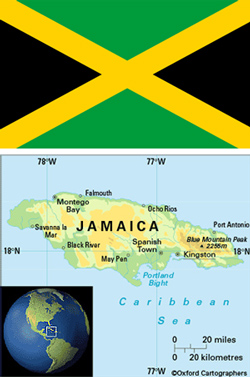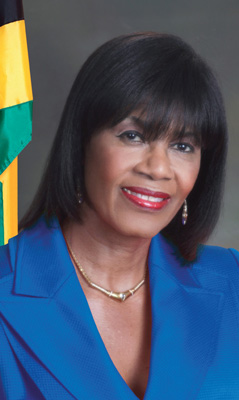Jamaican gov’t sees IMF successes but no benefits for the poor
By Zadie Neufville | Last updated: Jun 12, 2015 - 1:30:13 PMWhat's your opinion on this article?

The International Monetary Fund Building in Washington, D.C. Photo: MGN Online
‘In the long history of Jamaica’s on-again off-again relationship with the IMF, it is the poorest of this nation’s 2.8 million people who suffer the heaviest burden. With most earnings going to pay loans, there is nothing left for government assistance.’ |
The 32-year-old has been in several government-sponsored training programs and has even filed for help under the Program of Advancement Through Health and Education (PATH), a safety net set up to assist the poor. But she fails to qualify and can’t understand why.
The single mother spends each day making phone calls, sending messages and making as many trips as she can afford, hopeful that one will result in a job. Roxan is desperate to help her son who graduated high school last year and has qualified for college. Her daughter is in secondary school and is preparing to take exams.
Several miles away in the south coast village of Denbigh, the two elderly women sitting outside the May Pen Health Centre tell their stories of hardship. Five days a week, they scratch out a meagre living selling a few sweets, biscuits, some bottled water, drinks and fruits to make ends meet. Neither have pensions and none qualify for even the basic of government assistance under PATH.
Seventy-year old Elise Young’s small box of mixed sweets and biscuits and the plastic bucket containing some ice and a handful of drinks is hardly enough to pay the $18 electricity bill each month and buy food.

|
“It’s very rough but I still have to live,” she said, noting that her daughter, who generally helps out with a few dollars a week, is now unemployed.
Next to her sits Iona Samuels, an on-again-off again vendor who sells a few dozen oranges and bananas to make ends meet. Iona is lucky: she lives rent-free, house-sitting for a friend who lives in Canada. Her on-again off-again business is due to the many times she is unable to restock the plastic crates that serve as her stall because she uses all the cash to buy food and pay water and light bills.
“Sometime I buy two dozen oranges and two dozen bananas and I only sell half. Sometimes I don’t make a profit because I have to sell them for what I pay for them and I have to eat and pay the bills,” she explains.
Iona admits that advancing age has slowed her ability to do more strenuous work. She is concerned that government has no programs for “the poor and vulnerable” people like her.
The good fortune that allows Iona to live rent-free also goes against her in her quest for government assistance with her daily expenses.
“I live in a house that is fully furnished, so I am unable to qualify for anything. There is no consideration that the house is not mine. It is my friend’s house. There is a gas stove, and a television so I don’t qualify for help,” Iona complains.
In the long history of Jamaica’s on-again off-again relationship with the IMF, it is the poorest of this nation’s 2.8 million people who suffer the heaviest burden. With most earnings going to pay loans, there is nothing left for government assistance.

Prime Minister Portia Simpson Miller
|
After 20 years of improvement to the country’s poverty rate, the number of Jamaicans living below the poverty line has ballooned in recent years from 9.9 percent in 2007, to 12.3 in 2008, 16.5 percent in 2009 and 19.9 percent in 2012. And if the 2014 research by the local Adventist Church is correct, today there are 1.1 million Jamaicans living in poverty.
The most pressing problem is the country’s debt, which the government readily admits has severely hampered its economic growth. According to the World Bank website, Jamaica’s debt to GDP (Gross Domestic Product) ratio, estimated at 140 percent at the end of March 2015, is among the highest in the developing world.
For the Portia Simpson Miller-led administration that won the 2011 general elections on a ticket of being a friend of the poor, there is not much caring left, at least not under the IMF. The Planning Institute of Jamaica (PIOJ) reports that while the IMF program is necessary, it is still not sufficient to unlock the kind of growth necessary to boost the economy and grow jobs.
According to the PIOJ, “Economic recovery remains fragile” even as the country successfully completed the IMF assessments with improvements in most macro-economic indicators and outlook for growth.
The World Bank states on its website that, “For decades, Jamaica has struggled with low growth, high public debt and many external shocks that further weakened the economy. Over the last 30 years real per capita GDP increased at an average of just one percent per year, making Jamaica one of the slowest growing developing countries in the world.”
Simply put, Jamaica continues to spend far more than it earns. But while individual sectors continue to show improvements, manufacturers and the international community blame the cost of fuel, high energy costs and crime as impediments to growth.
Last year, Jamaica paid the IMF over $136 million more than it received, and the country still owes the World Bank and Inter-American Development Bank over $650 million through 2018. Even so, government continues to struggle to maintain social gains such as free healthcare and free primary and secondary education.
There are those who believe government is not doing enough to create jobs and that the available jobs are going to government supporters. There are those who blame the private sector, and they in turn point to a depreciating dollar, high cost of fuel and high-energy costs. And of course there is crime.
With unemployment rate at an alarming 14.2 percent and youth unemployment estimated at twice the national rate, things are not looking good for Roxan, who falls into that category.
INSIDE STORIES AND REVIEWS
-
-
About Harriett ... and the Negro Hollywood Road Show
By Rabiah Muhammad, Guest Columnist » Full Story -
Skepticism greets Jay-Z, NFL talk of inspiring change
By Bryan 18X Crawford and Richard B. Muhammad The Final Call Newspaper @TheFinalCall » Full Story -
The painful problem of Black girls and suicide
By Charlene Muhammad -National Correspondent- » Full Story -
Exploitation of Innocence - Report: Perceptions, policies hurting Black girls
By Charlene Muhammad -National Correspondent- » Full Story -
Big Ballin: Big ideas fuel a father’s Big Baller Brand and brash business sense
By Bryan Crawford -Contributing Writer- » Full Story






 Click Here Stay Connected!
Click Here Stay Connected!








